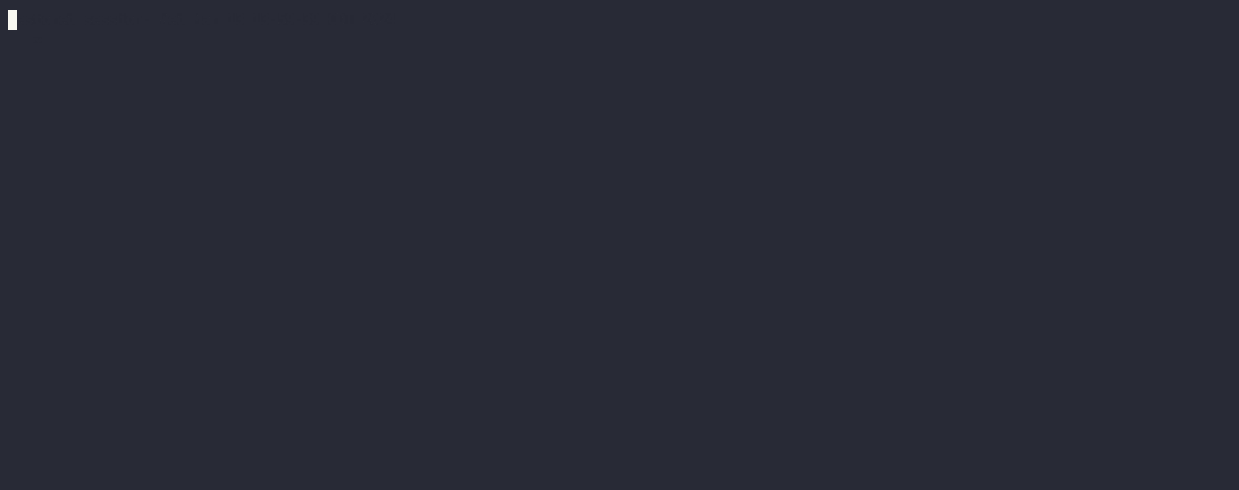This project is an attempt to make an interactive resume as a TUI application similar to efforts like This 2d animation portfolio.
The application itself is built with the data needed, to achieve this I've setup a build script
to generate a rust module that is only present at built time named source_data.rs
In a build.rs, the DATABASE static variable is generated by parsing a handful of toml files in a
specific directory layout corrisponding to the details of each view. The layout is outlined below.
The default location for this is a data directory in the current working directory when building,
this can be overridden by using the RESUME_DATA_PATH environment variable.
./data
├── edu.toml
├── info.toml
├── job_details
│ └── <Job Name or Id>
│ ├── bullet-1.toml
│ └── bullet-2.toml
├── jobs.toml
├── oss.toml
└── oss_details
└── <Project Name or Id>
├── subproject-1.toml
├── subproject-2.toml
└── subproject-4.toml
The primary entrypoint for the Home page is the info.toml file where the base information is
stored; it includes a name and a "tag line".
JSON Schema
{
"title": "Info",
"description": "Basic information",
"type": "object",
"properties": {
"name": {
"description": "The name displayed on the Home page.",
"type": "string",
},
"tag_line": {
"description": "The tagline to display below the name on the Home page.",
"type": "string"
}
}
}This file is the entry point for the professional experience portion of the resume. The top level is
an array of Job objects under the key job or jobs 1.
JSON Schema
{
"title": "Jobs",
"description": "List of job details",
"type": "object",
"properties": {
"jobs": {
"description": "list of jobs",
"type": "array",
"items": {
"type": "Job"
},
}
}
}Each Job object contains some basic information about the position including company name, title,
start date, optional end date, a list of details and an optional id. The list of details can either
be included directly in the toml file or can be stored in the job_details directory. job_details
is layed as directories, each directory will be named have either the company or id. The job
details when in the TOML file should be rendered in the order they are defined and any additional
details in teh job_details directory will be appended to this list in the order they are returned
from read_dir.
JSON Schema
{
"title": "Job",
"description": "Overview of each job",
"type": "object",
"patternProperties": {
"id": {
"description": "An optional unique ID for a job used for file based details when representing multiple jobs at the same company.",
"type": "string"
},
"company": {
"description": "The name of the company",
"type": "string"
},
"title": {
"description": "Job title at this company",
"type": "string"
},
"start": {
"description": "The date this position started",
"type": "string"
}
,
"end": {
"description": "The date this position ended, if not provided it will display 'current'",
"type": "string"
},
"details?": {
"description": "A list of job details",
"type": "array",
"items": {
"type": "JobDetail"
},
}
},
"required": [ "company", "title", "start" ]
}Each Detail is essentially a bullet point for this job, it will contain a headline, snippet and
long form description.
JSON Schema
{
"title": "JobDetail",
"description": "A highlight from a job",
"type": "object",
"properties": {
"headline": {
"description": "The headline",
"type": "string"
},
"snippet": {
"description": "A snippet describing this detail",
"type": "string"
},
"detail": {
"description": "The long form description, Commonmark markdown can be used to style this content",
"type": "string"
}
}
}This file is the entry point for the open source work portion of the resume. The top level is
an array of Project objects under the key projects or project 1.
JSON Schema
{
"title": "Projects",
"description": "List of oss projects",
"type": "object",
"patternProperties": {
"projects?": {
"type": "array",
"items": {
"type": "Project"
},
}
}
}A Project is a recursive data structure for describing open source contribution it contains a
project name, short description, long description and a list of sub projects. This structure
makes it easier to represent GitHub Organizations and their repositories and/or crates
that have workspace crates that deserve additional details.
JSON Schema
{
"title": "Project",
"description": "A Project outline",
"type": "object",
"properties": {
"name": {
"description": "The name of the project",
"type": "string",
},
"short_desc": {
"description": "A snippet about this project",
"type": "string"
},
"long_desc": {
"description": "A long form overview of this project, Commonmark markdown can be used to style this content",
"type": "string"
},
"sub_projects": {
"description": "A list of sub-projects related to this project, this is recursive in nature so these sub projects can also have sub-projects",
"type": "array",
"items": {
"type": "Project"
}
}
},
"required": ["name", "short_desc", "long_desc"]
}This file is the entry point for the open source work portion of the resume. The top level is
an array of School objects under the key schools or school 1.
JSON Schema
{
"title": "Education",
"description": "List of school details",
"type": "object",
"patternProperties": {
"schools?": {
"type": "array"
"items": {
"type": "School"
},
},
}
}A School is a breif description of an educational experience including the name of the institution
a description of the course of study and an optional graduation date.
JSON Schema
{
"title": "School",
"description": "Description of schooling",
"type": "object",
"properties": {
"name": {
"description": "The name of the institution",
"type": "string"
},
"desc": {
"description": "A description of this course of study",
"type": "string"
},
"graduation_date": {
"description": "If completed, when that happened",
"type": "string",
}
},
"required": ["name", "desc"]
}Footnotes
-
Because toml allows for 2 array syntaxes, array properties have a serde
aliasto allow them to be formatted as either an inline array (<list-name> = []) or with the[[<list-name>]]syntax. I personally find it to be more plesent to use the plural name for the former and non-plural for the latter. ↩ ↩2 ↩3
